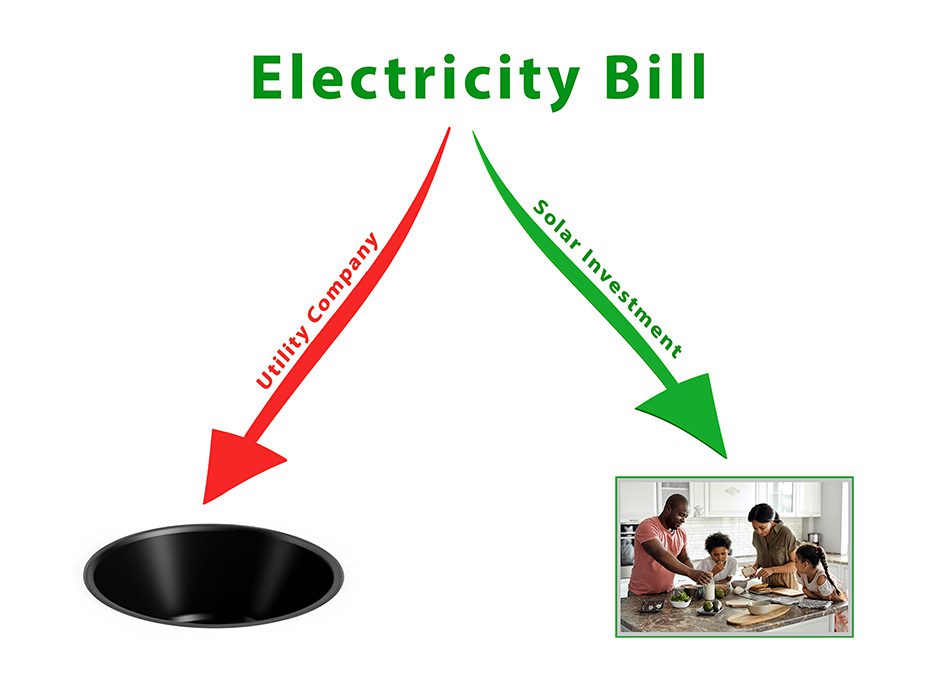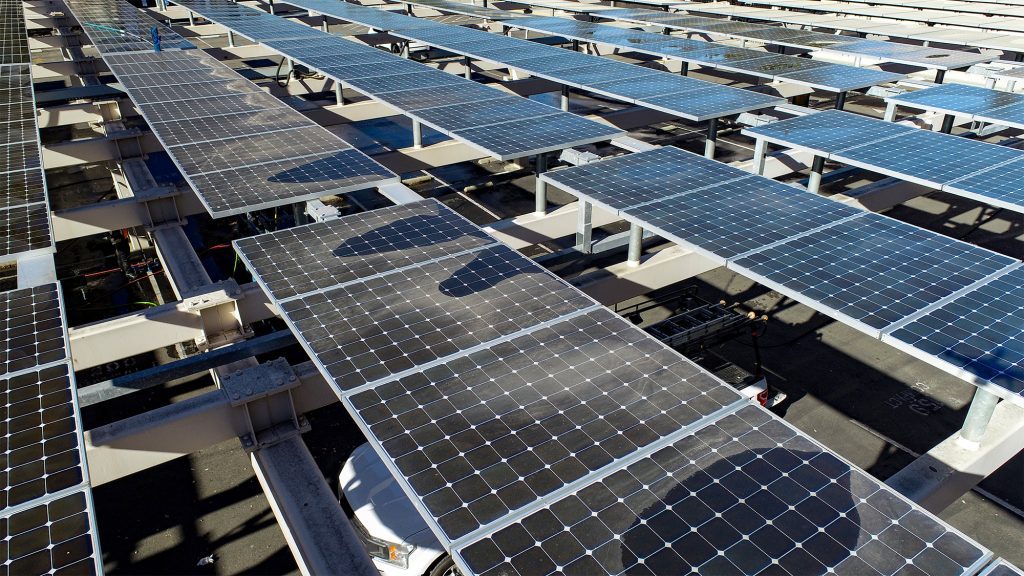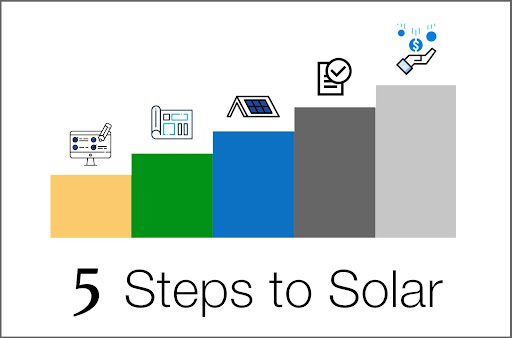Are you considering making the switch to solar power for your home? Solar energy offers a sustainable, cost-effective way to power your home, but it’s important to be informed about the process. Before you take the leap, here are 7 things you should know to ensure you’re ready for a successful transition to solar energy. This free guide was designed to help you with your move to solar. Let’s get started.
1. Understand Your Current Energy Bill Fees
One of the first things to consider when switching to solar is understanding your current energy bill. Your energy bill includes not only the cost of the electricity you use but also additional fees such as delivery charges, service fees, and taxes. These fees can add up quickly, and when switching to solar, it’s crucial to know how they break down. A good understanding of your bill will help you determine how much you can save with solar and what changes you can expect in your energy costs once you make the switch.
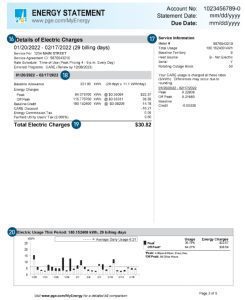
For example, in the image above we see the following break down of energy charges:
16. Details of PG&E Electric Charges: The billing date you are being charged for, your address, your service agreement ID (which is different than your account number), your rate plan, and any programs you are enrolled in.
17. Service information: Your meter number, the reading at the time your bill was assessed, the reading at the time your last bill was assessed, your total usage in Kilowatt hours which is the energy delivered by one kilowatt of power for one hour, the baseline territory (this is a letter assigned to you based on where you live. You are given an allotment of energy at a lower rate that goes up if you use more. You can find more about that here[PG&E]), Your heat source (If you see a “B” this means you are registered with a non-electric heat source; if you see “H” this means you are registered with an electric heat source), A Serial (e.g. V), and which Rotating Outage Block you are in when they decide to turn off power in an area to reduce demand on the electric grid.
18. Electricity usage: Your electricity usage during billing dates. This includes if it was Tier 1 or Tier 2 power. Tier 1 is billed at a lower price. Once your usage surpasses your allowance, you are billed at the higher tier 2 rate. Energy used during ‘peak’ hours is charged at a higher rate than energy that is used during ‘part peak’ and ‘off peak’ hours. More information here [PG&E]
19. Total Electric Charges: The total charges for your electric use, including any credits and applicable taxes.
20. Electric Usage This Period: A visual representation of your energy usage for the billing term.
Understanding your energy usage and what you are being billed for every month will help the solar installation company come up with a plan for you to save the most money possible.
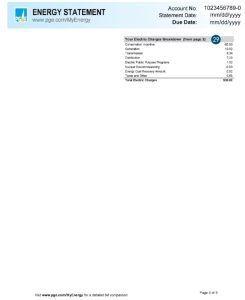
In the image above, we see a sample of what page 5 of your PG & E bill might look like. This includes fees such as:
Transmission: Cost of transmitting electricity from power plants, over high-voltage lines and towers, to the distribution system.
Distribution Charge: Charge for the lower-voltage system of power lines, poles, substations and transformers directly connecting PG&E distribution lines to homes and businesses.
Public Purpose Programs: Funding programs considered by law to benefit society, such as low-income ratepayer assistance and energy efficiency.
Nuclear Decommissioning: Fee to restore closed nuclear plant sites to as near their original condition as possible.
Wildfire Fund Charge: Charge on behalf of the State of California department of Water Resources (DWR) to fund the California Wildfire Fund. These charges belong to DWR, not PG&E.
Recovery Bond Charge/Credit: Your bill for electric service includes a charge that has been approved by the CPUC to repay bonds issued for certain costs related to catastrophic wildfires. The Recovery Bond Charge (RBC) rate is currently $0.00597 per kWh. PG&E has also contributed certain amounts to a trust fund which is used to provide a customer credit equal to $0.00597 per kWh (Recovery Bond Credit). The right to recover the RBC has been transferred to one or more Special Purpose Entities that issued the bonds and does not belong to PG&E. PG&E is collecting that portion of the RBC on behalf of the Special Purpose Entities.
Wildfire Hardening Charge: PG&E has been permitted to issue bonds that enable it to recover more quickly certain costs related to preventing and mitigating catastrophic wildfires, while reducing the total cost to its customers. Your bill for electric service includes a fixed recovery charge called the Wildfire Hardening Charge that has been approved by the CPUC to repay those bonds. The right to recover the Wildfire Hardening Charge has been transferred to a separate entity (called the Special Purpose Entity) that issued the bonds and does not belong to PG&E. PG&E is collecting the Wildfire Hardening Charge on behalf of the Special Purpose Entity. For details visit the Wildfire Hardening Fixed Recovery Charge document (PDF).
Competition Transition Charges (CTC): Charge for legacy electricity contracts, signed prior to 1998, that exceed a CPUC-approved market price limit.
Energy Cost Recovery Amount (ECRA): Charges imposed pursuant to law to help reduce the costs of financing the PG&E emergence from bankruptcy. One of these charges is the Dedicated Rate Component (DRC). The right to receive DRC revenues was sold to a special purpose entity: the PG&E Energy Recovery Funding LLC. PG&E is collecting this charge on behalf of PG&E Recovery Funding LLC. The charge does not belong to PG&E.
Power Charge Indifference Adjustment (PCIA): The PCIA is a charge to ensure that both PG&E customers and those who have left PG&E service to purchase electricity from other providers pay for the above market costs for electric generation resources that were procured by PG&E on their behalf. ‘Above market’ refers to the difference between what the utility pays for electric generation and current market prices for the sale of those resources. Visit pge.com/cca.
2. Learn how a Home Solar Installation Works
Solar installations may seem complex, but they operate on a simple principle: capturing sunlight to generate electricity. Here’s a breakdown of the key components:
- Solar Panels: These absorb sunlight and convert it into direct current (DC) electricity.
- Inverter: The inverter changes the DC electricity received by the sun into alternating current (AC), which is the type of electricity used in your home.
- Battery Storage: Some systems include batteries that store excess energy produced during the day for use at night or during power outages.
- Wiring: Proper wiring connects all components, ensuring that the solar energy flows seamlessly to your home’s electrical system.
Understanding these parts is essential when planning your solar system to ensure it meets your energy needs.
3. Find Out How Much Solar Actually Costs
The cost of solar panels has dropped significantly in recent years, but it’s still important to assess the full cost of installation, including equipment, labor, permits, and any necessary upgrades to your home’s electrical system. Solar costs can vary depending on your location, the size of your system, and any government incentives available to you. While it may require an upfront investment, keep in mind that solar can significantly lower your monthly electricity bills and offer long-term savings. It’s important to get multiple quotes from the best solar companies in the Bay Area to make sure you have a great experience at a fair price.
4. Learn What Happens If You Produce More Energy Than You Need With Net Metering Policies
One of the great benefits of solar power is the ability to generate more energy than you use. This is where net metering comes in. Net metering allows you to send excess energy back to the grid, and in return, you receive credits on your electricity bill. These credits can be used to offset energy costs during periods when your system isn’t producing enough power (such as during cloudy days, winter months, or at night). Be sure to understand California’s net metering policies, as they can vary, and some areas may offer better incentives than others. Learn more about how net metering works in this fun blog post we did. The difference in what you produce and consume is summarized in your annual true up bill. Watch the video “What Is a True Up Bill” for more information.
5. Understand How the Solar Installation Process Works and How Long It Will Take
The installation of solar panels is a relatively straightforward process, but it does require some planning. Here’s a general timeline:
- Consultation and Site Evaluation: A solar provider like Synergy Power will assess your roof’s condition, energy needs, and determine the ideal system size.
- Design and Permits: We will design the system and obtain the necessary permits.
- Installation: A team will install the panels, inverter, and wiring. This typically takes 1-3 days.
- Inspection and Activation: After installation, your system will be inspected to ensure it meets all codes and regulations. Once approved, your system will be activated. The entire process typically takes 2-3 months from consultation to activation, depending on permits and inspections. Sometimes this time frame can be longer if there is a delay in parts or if a lot of people are signing up for solar at the same time.
6. What Do I Need to Know About Maintenance and Cleaning?
Solar panels require minimal maintenance. They are designed to withstand the elements and need very little upkeep. However, to ensure they operate efficiently:
- Cleaning: Dust, debris, or bird droppings can block sunlight from reaching the panels. While rain can naturally clean panels, you may need to hose them down occasionally or hire a professional for a deep clean, especially in dusty areas. Read more about how to clean solar panels here.
- Inspection: It’s a good idea to have your system checked periodically to ensure all components are working correctly. Most systems are very low-maintenance, but it’s important to stay proactive to keep your solar investment performing at its best.
7. Find Out the Warranty on Your Solar Installation and How Long It Will Last
Solar installations typically come with warranties for both the equipment and the labor.
- Panels: Most solar panels come with a 20-25 year warranty, which covers performance and efficiency. Manufacturers guarantee that the panels will produce at least 80% of their original capacity during this time.
- Inverters: Inverters typically come with a 10-15 year warranty, although some higher-end models offer extended warranties.
- Labor: Installation warranties typically range from 1 to 10 years, depending on the installer. Be sure to read the fine print of your warranty to understand what is covered and how long it lasts, as this can vary by manufacturer and provider.
Switching to solar is a big decision, but with the right knowledge, it can be a smooth and rewarding process. By understanding your energy bill, the installation process, costs, and ongoing maintenance, you’ll be well on your way to making an informed decision that will save you money and help the environment.
If you would like to read more about making the move to solar, check out some of these other resources:
https://www.pge.com/assets/pge/localized/en/docs/clean-energy/solar/pge-solar-billing-plan-guide.pdf
https://synergypower.com/from-signing-to-savings-5-steps-to-switch-to-solar/



